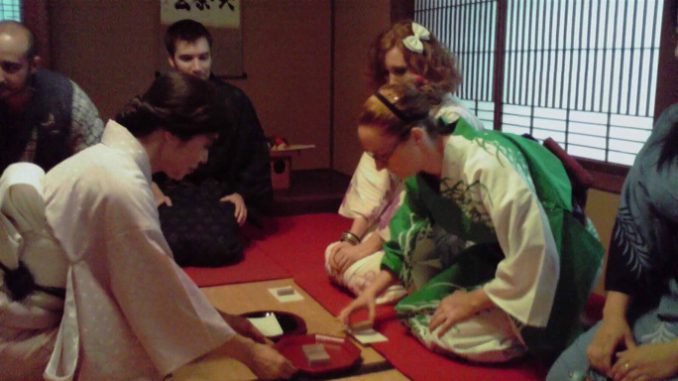
茶道【SADOU】is the most recommended first experiences because it contains a lot of Japanese culture elements like an exhibition!!
It usually contains below and you can experience all of them if you joined 茶会【CHA-KAI】or 茶事【CHA-JI】at once;
<1.抹茶【matcya】/2.和菓子【wagashi(Japanese sweets)】/3.着物【kimono】/4.陶器【touki(pottery)】(抹茶茶碗【matcha tea bowls】)/5.漆器【shikki・urushi /JAPAN lacquer ware)】/6.鋳物【imono(ironware)】(釜【kama(kettle)】)/6.竹細工【bamboo tools)】茶筅【chasen(bamboo whisk)・茶杓【chashaku(tea scoop)】/7.掛け軸【kakejiku(hanging scroll)】/8.香【kou(insence)】/9.花【hana(flowers)】/10.扇子【sensu(paper fan)】/11.懐石料理【kaiseki-ryouri(kaiseki cuisine)】12.和風建築【wafuu(Japanese style)-architecture)】/13.庭【(garden) 】/ 14.禅【ZEN Buddhism】/ 15.所作【Shosa(Bahavior)】/16. おもてなし【omotenashi(Welcome-maind)】 , so on.>
Have you ever ate MATCHA Ice Cream, MATCHA Chocolate
or MATCHA latte☕?
Then, how about a bowl of 抹茶【MATCYA(Green Powdered Tea)】in 抹茶茶碗【MATCHA-C(Z)HAWAN(Tea Bowl for Matcha)】?
If you felt it’s not just a beverage, but there would be a world which is something profound on the back of one tea bowl , that feeling might be true♪
In Japan, many things become 道【MICHI/DOU(WAY or ROAD)】which should be mastered . Like 書道【SHO-DOU】The Way of Calligraphy, 剣道【KENDOU】The Way of Sword, 合気道【AIKI-DOU】, 空手道【KARATE-DOU】, 香道【KOUDOU】The Way of Incense, 華道【KADOU】The way of flower …and 茶道【SADOU】,”The Way of Tea”.
CONTENTS:
▶1.ABOUT 抹茶【MATCHA】AS A DRINK: FEATURES AND NUTRITION
▶2.HISTORY OF SADOU: THE MOST FAMOUS TEA MASTER 千利休【SEN NO RIKYUU】AND WHAT’S 侘び寂び【WABI-SABI】?
▶3.INFRUENCES OF 禅【ZEN-BUDDISM】IN TEA CEREMONIES.ZEN words are on hanging scrolls and it is a theme of the tea ceremony.
▶How different お茶事【O-CHAJI】from お茶会【O-CHAKAI】? O-CHAJI is large symphony last about 4 hours while CHAKAI is only one part of it.
▶Recommended: 4.TEA CEREMONY FOR BEGINNERS. If only you know those simple rules, you can enjoy Tea ceremony with fun!!!
PROLOGUE :
抹茶【MATCHA】or Green Powdered Tea is popular as healthy drink all over the world recently.
Amazingly, it has two components great for meditating!
▶1.ABOUT 抹茶【MATCHA】AS A DRINK: FEATURES AND NUTRITION
In addition to that, when it is served at 茶会【CHA-KAI(Tea Ceremonies)】 in Japanese 茶道【SADOU】”The way of Tea”, just to drink this beverage become very artistic and philosophical act.
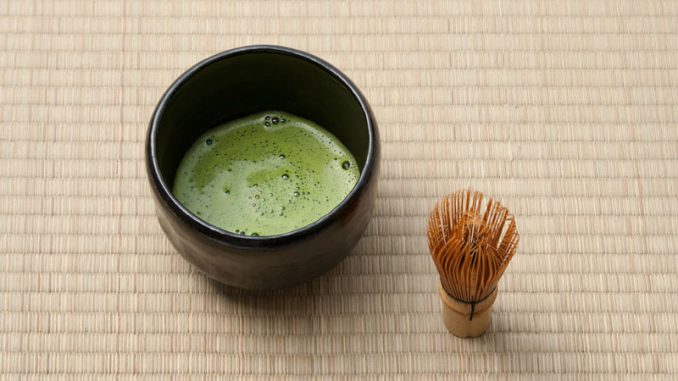
In a serenity of tea room, one bowl of MATCYA green powdered tea is prepared politely and carefully. The movements is called 点前【TEMAE】, which has not been changed almost for more than 400 years since tea master 千利休【SEN NO RIKYUU】had established it.
▶2.HISTORY OF SADOU: THE MOST FAMOUS TEA MASTER 千利休【SEN NO RIKYUU】AND WHAT’S 侘び寂び【WABI-SABI】?
There are a lot of secrets for enjoying silence in the tea room. All things in a tea room including flowers, tea bowls, tea scoops and sweets are selected and arranged by 亭主【TEISYU(the host of tea party)】following a theme of 禅語【ZENGO(ZEN-WORDS)】on the hanging scroll at alcove.
It was born from 禅【ZEN】monk’s culture and completed by great tea master,千利休【SEN‐NO‐RIKY
CONTENTS:
1.History of 茶【CHA/tea】.Tea was drunk as medicine to awake and shape their spirits in rituals by noble people and monks.
2.What’s 侘び寂び【WABI-SABI】?The most famous tea master千利休【SEN NO RIKYUU】has established and completed the way of tea.
3.Nowadays,茶道【SADOU】is complehensioned AND THERE ARE MORE THAN ABOUT 50 SECTS.
1.History of 茶【CHA/tea】.Tea was drunk as medicine to awake and shape their spirits in rituals by noble people and monks.
The custom of drinking 茶【CHA(tea)】was imported by ancient China called 宋【SOU】about 1300 years ago. Japan was around the beginning of 平安時代【HEIAN period(794-1185)】and tea leaves were brought by monks as exchanged students. At that time, tea was drunk as medicine only in temples to awake and shape their spirits in rituals and taken only among monks and noble aristocrats including emperors in royal coat.
In the age of 鎌倉時代【KAMAKURA-period(1185-1333)】about 700 years ago, tea leaf’s domestic plant has been started by a monk 栄西【EISAI】 in 京都【KYOUTO】.
There is a description that a 将軍【SHOUGUN】in 鎌倉【KAMAKURA(1185-1333)】age drunk tea as a medicine of hangover.
2.What’s 侘び寂び【WABI-SABI】?And The most famous tea master千利休【SEN NO RIKYUU】.
When it comes to 戦国時代【SENGOKU-JIDAI(Battle Ages/1467‐1615)】 about 400-500 years ago,
many 戦国武将【SENGOKU-BUSYOU(Samurai Leaders/domestic loads of worriers)】 often hold large, gorgeous Tea Parties. The early times of tea culture was like a flashy and noisy “gamble” betting very expensive 唐【TOU/KARA】(Ancient name of China ) and 高麗【KOURAI】(ancient country placed in Korean now ) tea utilities and it was called 闘茶【TOUCHA(Tea-Battle)】.
Many Samurais addicted to correcting very expensive foreign tea tools(at that age, sometimes one tea bowl worth one castle!).
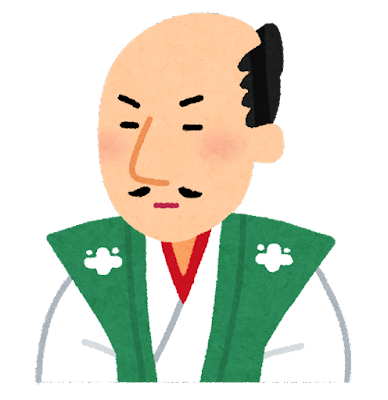
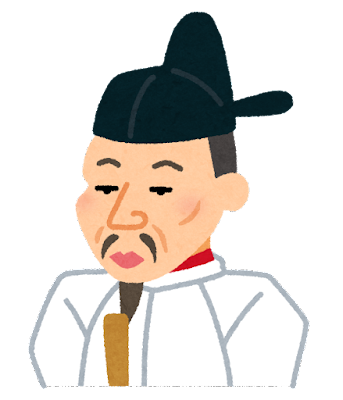

Famous ones were 織田信長【ODA-NOBUNAGA】, 豊臣秀吉【TOYOTOMI-HIDEYOSHI】and 伊達政宗【DATE-MASAMUNE】, 細川忠興【HOSOKAWA-TADAOKI】、古田織部【FURUTA-ORIBE】,金森宗和【KANAMORI-SOUWA】and more.
At the age of 8th. 将軍【SHOUGUN(General)】 足利義政【ASHIKAGA-YOSHIMASA】in 室町時代【MUROMACHI-AGE(1336‐1573)】 who let ZEN monks who came back from exchange abroad build 銀閣寺【GINKAKUJI(literally mean “Silver Temple”)】 which has calm and simple atmosphere which is influenced by ZEN style(It was opposite style to 金閣寺 【KINKAKUJI(Golden Temple)】,which was built by the order of 3rd. general 義満【YOSHIMITSHU】, having luxury and gorgeous mood which was also popular among people like nobles and samurais).
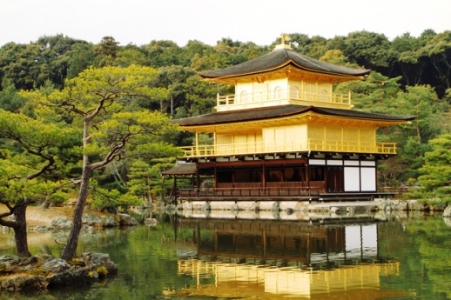
A ZEN monk from 大徳寺【DAITOKUJI-TEMPLE】村田珠光【MURATA-JYUKOU】, he was an aide monk of the8th.将軍【SHOUGUN(A leader of all Samurais/literally mean General)】足利義政【ASHIKAGA-YOSHIMASA】. 珠光【JYUKOU】 advised YOSHIMASA to prohibit the gambling Tea battle. And he put forward more simple, calm and emphasized spiritual Tea style, according to the value of 禅【ZEN】 Buddhism.
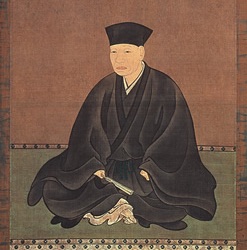
Following by 武野紹鴎【TAKENO-JYOUOU】The most famous Tea Master 千利休【SEN NO RIKYUU】 became a teacher of Tea for NOBUNAGA and HIDEYOSHI.
They proposed to leave from foreign ways of values and created Japanese original values like 侘び寂び【WABI-SABI】;literally means ” Rusting and Tranquility” things which are not gorgeous, simple and imperfect and rusting things with ages”.
It became very important Japanese aesthetic sensibilities, which prefer beauty come from simplicity and imperfection, or serenity or tranquility that come with age.
It is said that the mind of WABI-SABI is appeared in this old poem made by 藤原定家【FUJIWARA-TEIKA】 (From 万葉集【MANYOU-SYUU】poem anthology of 平安【HEIAN】period).
Overviewing,
No Flowers nor No red leaves anymore
Only Poor hut on the Beach in Autumn’s Dusk.

They preferred imperfect, missing things instead of perfect, gorgeous thigs and this value become very important in SADOU. He created original Japanese tea bowls called 黒楽【KURO-RAKU】and 赤楽【AKA-RAKU】, used hand-made bamboo scoops,
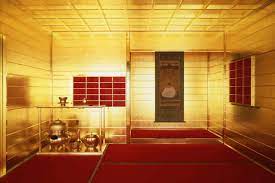
and made very small, simple tea room like 待庵【TAI-AN】while the ruler of that time 豊臣秀吉【TOYOTOMI-HIDEYOSHI】 made a golden, brilliant tea room.
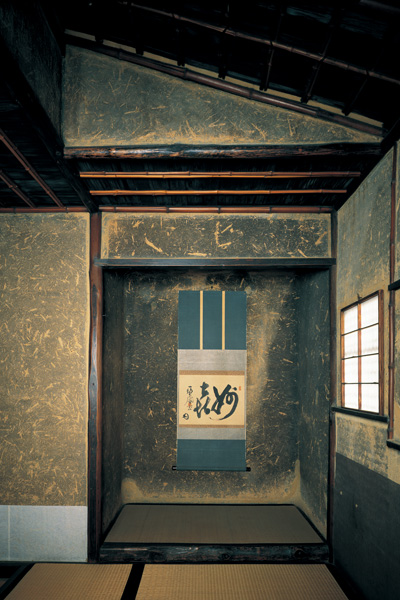
Finally, 豊臣秀吉【TOYOTOMI-HIDEYOSHI】 compelled 千利休 to cut his stomach 切腹【SEPPUKU/HARAKIRI】 by himself. And the reason is still mystery in Japan, even there are many theories.
▶ESSAY: Why 千利休【SENNNO-RIKYUU】made 切腹【SEPPUKU】by豊臣秀吉【TOYOTOMI-HIDEYOSHI】?<COMING SOON>
That is the not want too much, unperfect simple things are enough, seek beauties and satisfy with what we have already. If we want gorgeous, perfect things, we can not satisfied forever. If we can love only perfect things, it is difficult to love in this world. If we can love unperfect thigs we already have, there are a lot of things to be loved in this world. And we can satisfy with which we already have, needless to conquest other countries.
I think it had been very important theme in this country from the ancient time.
ESSAY: 「The sense of values in Japan in each ages :もののあはれ【MONONO-AHARE】in 平安【HEIAN】 period, 幽玄【YUUGEN】in 室町【Muromachi】,粋【IKI】in EDO…and Now is かわいい【KAWAII】!」
After a country unified by 徳川家康【TOKUGAWA IEYASU】, SADOU become popular among common people too, in the peaceful era called 江戸【EDO】period.
3.Nowadays,茶道【SADOU】is inherited and there are more than 500 sects nowadays.


After modernization, from the end of 江戸【EDO】to 明治【MEIJI-ERA(1868-1912)】,peoples of conglomerates called 財閥【ZAIBATSU】aesthetic eyes collect utilities like 益田鈍翁【MASUDA-DONOU(1848‐1938)】.
And after W.W.2, it become practices of manners and trains for women to be good brides. So nowadays, an image of SADOU is women’s culture and there are many women over certain age are trained and enjoying 茶道【SADOU】 as one of cultural educations in Japan.
▶3.INFRUENCES OF 禅【ZEN-BUDDISM】IN TEA CEREMONIES.ZEN words are on hanging scrolls and it is a theme of the tea ceremony.
By the way, there are 2 kind of Tea ceremony divided:茶会【CHAKAI】and 茶事【CHAJI】. 茶会 is also divided into 大寄席【OOYOSE(Many peoples in a large room 】and 小間【KOMA(Small number of peoples in a Small Room)】.
1.What’s 禅【ZEN】? It’s one of the methods to reach an enlightenment of Buddhism started by 達磨【DARUMA】.
Japanese 仏教【BUKKYOU(Buddhism)】
Have you heard a word 禅【ZEN】? It is said that it’s one of the ways to reach 悟り【SATORI(Enlightenment)】in Buddhism. Through meditation with 座禅【ZA-ZEN(Sitting ZEN)】,through away your unnecessary and extra thoughts, without thinking anything and become 無【MU(Nothing, Zero)】state. Then, find an answer which is inside of you and try to close an Enlightenment state named 悟り【SATORI】.

A founder of 禅宗【ZEN-SHUU(ZEN-BUDDHISM)】was 達磨【DARUMA(Bodhidharma)】

The book named 禅【ZEN】written by 鈴木大拙【SUZUKI-DAISETSU】was introduced to America and it became popular in 1950’s.
ZEN sprit influenced to American Hippie culture as same as Indian’s YOGA and other thoughts of oriental philosophies.

Recently, ZEN become a topic because Apple’s CEO Steve Jobs was into it.
I think ultimately simple and sophisticated design of Apple products is based on ZEN philosophy.
On the ultimately simple white screen or device like pc, the apple’s symbol mark increases it’s presence vividly.
At the same time, for example i-phone unite digital represented by 0 or 1 , and touch the screen by human fingertips and oversize or shrinks by moving fingers sensation.

2. In it’s early history,茶【CHA/TEA】in Japan was drunk at 禅寺【ZEN TEMPLE】and much of famous tea masters were ZEN monks.
A Buddhist monk 栄西【EISAI】who went to 宋【SOU】 in 15C as an exchange monk was a monk of 臨済宗【RINZAI-SYUU(RINZAI-sect)】of 禅宗【ZENSHUU(ZEN-SECT)】. He brought back 茶【CHA(Tea)】to Japan and a custom to drink tea before ZEN meditation in ZEN temple like 大徳寺【DAITOKUJI】.
At that age ( from end of 鎌倉【KAMAKURA】to 室町【MUROMACHI】era )a lot of arts like paintings, poems, architects and dramas were influenced by 禅【ZEN】Style.
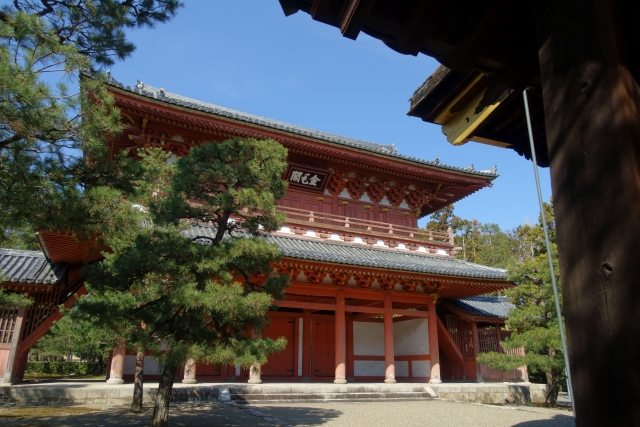
Most of famous founders of SADOU in early time like 村田珠光【MURATA-JYUKOU】, 武野紹鴎【TAKENO JYOUOU】and the most famous tea master,千利休【SENNO RIKYUU】. JYOUOU and RIKYUU were merchants of 堺【SAKAI】, but They took permissions called 印可【INGA】from 大徳寺【DAITOKU-JI】ZEN Temple. 印可【INGA】is an application or certification that improves some ones have reached 悟り【SATORI】by answering question of 禅問答【ZEN-MONDOU(ZEN questions and answers)】.
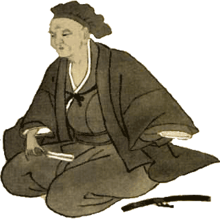
JYOUOU and RIKYUU were merchants of 堺【SAKAI】, but They took permissions called 印可【INGA】from 大徳寺【DAITOKU-JI】ZEN Temple. 印可【INGA】is an application or certification that improves some ones have reached 悟り【SATORI】by answering question of 禅問答【ZEN-MONDOU(ZEN questions and answers)】.
3. Basically, a 禅語【ZENGO(ZEN-Word)】is displayed on the 床の間【TOKONOMA(Alcove)】in a tea room and it is a theme of the tea ceremony.
Traditional architect style of お茶室【O-CHASHITU(Tea Room)】is 禅宗様式【ZENSHUU-STYLE】.
In a very small and so simple style room, there is a 床の間【TOKONOMA(Alcove)】.During Tea Ceremony, definitely 3 set of お軸/掛け軸【OJIKU/KAKEJIKU(Hanging Scroll), 花【HANA(Flower)】and 香合【KOUGOU(Seramic small container for Incenses)】are displayed on it.

Basically hanging scrolls displayed in tea ceremonies are (it might be different depend on it’s sect though,) 禅語【ZENGO(ZEN-Words)】written by monks of 大徳寺【DAITOKUJI-Temple】.
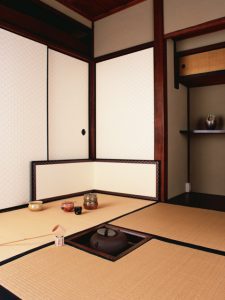
And a content written on the hanging scroll become a theme of that tea ceremony.
All tea tools like tea bowls, a name of a tea scoop, a name of sweet so on are arranged followed by the theme( It is interesting and a joy for guests to find them one by one which are hidden by host. The more you are familiar with the way of tea, the more you would find these points and it would become an lifetime-endless hobby ).
Then, when you visited the tea ceremony and ZEN words are on the alcove, it might be said you and hosts are training of 禅【ZEN】by feeling and thinking about the word deeply.
4. About popular 禅語【ZEN-GO(ZEN-words)】which is often used on hanging scroll in a tea room and become the theme of a tea ceremony.
お茶会でよく掛けられる禅語には以下のような物があります。
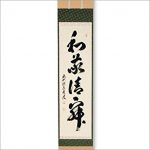
●喫茶去【KISSAKO】:Welcome to our tea room. Any way, please feel free to have a bowl of tea without difficult manners nor things.
●日々是好日【NICHI NICHI KORE KOUJITSU】:Even it is a rainy day, a windy, a snowy or a sunny day, it is a fine day.
●一期一会【ICHIGO-ICHIE】:Today, this time, this moment is only one time and n, this moment is only one time and never happen again. You can not meet the same person in the same situation. So, please appreciate enough every moments as if they are the last times.
●和敬清寂【WA-KEI-SEI-JYAKU(Harmony-Respect-Purify-Silence/Serenity)】
When Harmonized【和】, Respect【敬】each other, and Purify【清】 of things and mind, all happened together,then Silence【寂】 appears.
▶How different お茶事【O-CHAJI】from お茶会【O-CHAKAI】? O-CHAJI is large symphony last about 4 hours while CHAKAI is only one part of it.
There are interesting rules based on original philosophy. Just enjoying taste 抹茶【MATCHA】and 和菓子【WAGSHI】in a peaceful mood is great enough though,if you got some knowledges in advance, it would make your experience of tea ceremony more special and meaningful.
▶Recommended: 4.TEA CEREMONY FOR BEGINNERS. If only you know those simple rules, you can enjoy Tea ceremony as much as 30 times!
If you wanted to make delicious 抹茶【MATCHA】at your home, please check this article.
